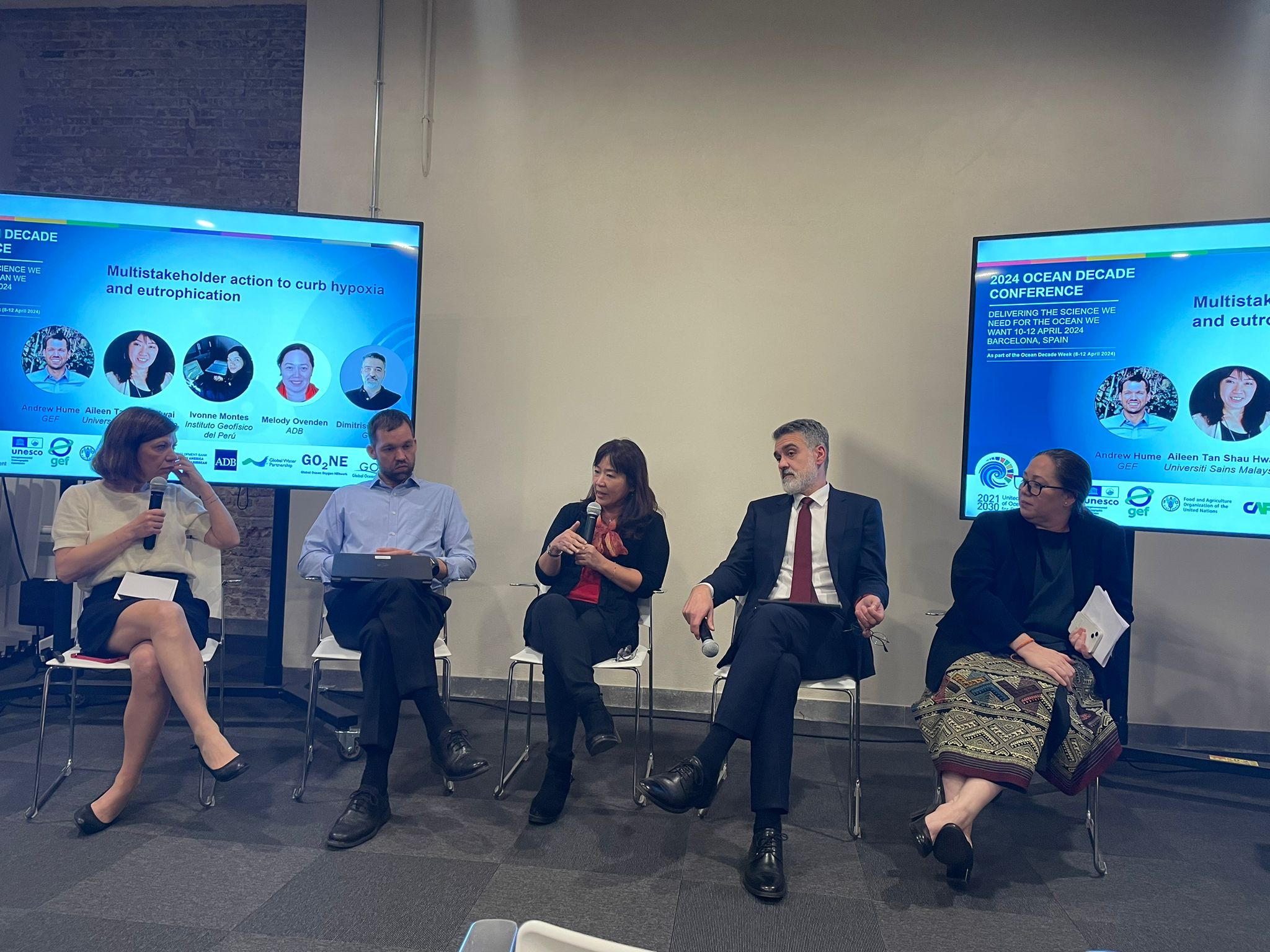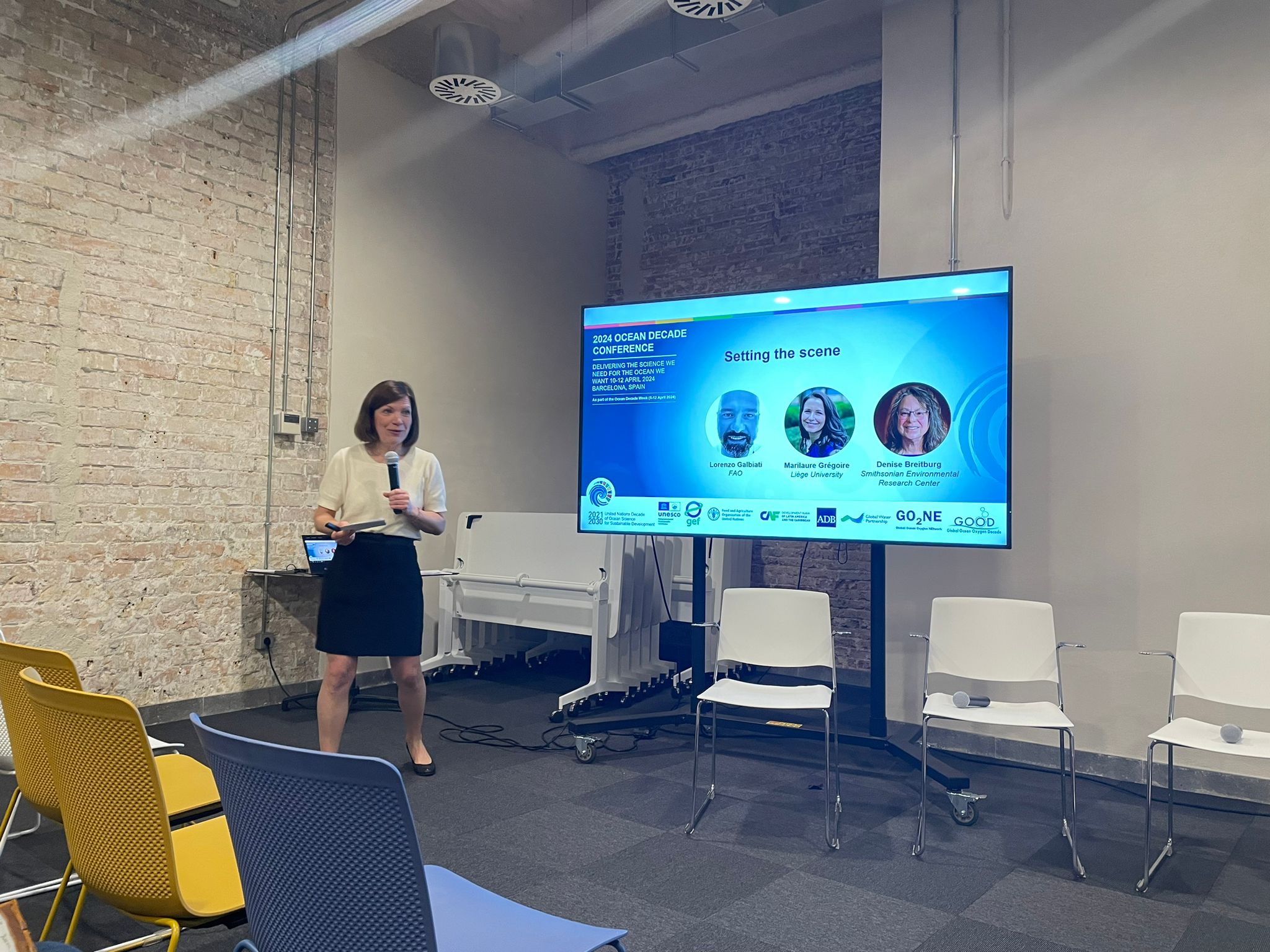 News
News
The Ocean's Meridional Oxygen Transport
Abstract.
"Quantification of oxygen uptake at the ocean surface and its surface-to-interior pathways is crucial for understanding oxygen concentration change in a warming ocean. We investigate the mean meridional global oxygen transport between 1950 and 2009 using coupled physical-biogeochemical model output. We introduce a streamfunction in latitude-oxygen coordinates to reduce complexity in the description of the mean meridional oxygen pathways. [...]".
Source: Wiley Online Library
Authors: Esther Portela et al.
DOI: https://doi.org/10.1029/2023JC020259
New approaches to combat eutrophication and hypoxia
 "The satellite event 'New approaches to combat eutrophication and hypoxia' brought together partners under the GEF-8 Clean and Healthy Ocean Integrated Program (CHO-IP) for introductions and to begin the next phase of tackling eutrophication and hypoxia in 14 national child projects.
"The satellite event 'New approaches to combat eutrophication and hypoxia' brought together partners under the GEF-8 Clean and Healthy Ocean Integrated Program (CHO-IP) for introductions and to begin the next phase of tackling eutrophication and hypoxia in 14 national child projects.
Representatives of partner organisations, the Food and Agriculture Organization of the United Nations (FAO), Asian Development Bank (ADB), Development Bank for Latin America (CAF), European Bank for Reconstruction and Development (EBRD), together with the IOC-UNESCO Global Ocean Oxygen Network (GO2NE) and the Global Water Partnership (GWP) discussed the program aims and objectives over the course of a 90 minute deoxygenation primer, panel discussion and Q&A session.
Keys points expressed by participants included that:
- Partners across scales and sectors must be involved early, with appropriate financing mechanisms, and engaged throughout to foster project ownership and outcome longevity.
- Scientific data, and methods of access, must be shared openly.
- Science will be unheeded unless it is delivered in a manner that is clear, timely, intelligible, and contextualised and translated to those who have, or will have, the capacity to use it.
- Collaboration with regional actors must be enhanced to aid identification of the most effective science-based actions that will have the highest impact in regional contexts, rather than following global trends.
- International institutions must be encouraged to identify and engage with initiatives of actors in their networks that may already be addressing or adapting to hypoxic conditions.
- Scientifically well-versed personnel are needed in Development Banks and other institutions positioned to leverage existing networks to tackle deoxygenation and other marine issues.
Partners will now move ahead with the program's Global Coordination Project and begin to make connections to national actors and networks working to address eutrophication and hypoxia and implement the program in the 14 participating countries.
The program will synergise with the Global Ocean Oxygen Database and Atlas (GO2DAT), an endorsed action under the UN Ocean Decade of Ocean Science for Sustainable Development and may lead to the development of new Actions as the program is implemented."
Contact: go2ne-secretariat@unesco.org
More information:
The 'New approaches to combat eutrophication and hypoxia' event
The GEF Clean and Healthy Ocean Program
IOC-UNESCO program announcement


Eddy-Mediated Turbulent Mixing of Oxygen in the Equatorial Pacific
Abstract.
"In the tropical Pacific, weak ventilation and intense microbial respiration at depth give rise to a low dissolved oxygen (O2) environment that is thought to be ventilated primarily by the equatorial current system (ECS). The role of mesoscale eddies and vertical mixing as potential pathways of O2 supply in this region, however, remains poorly known due to sparse observations and coarse model resolution. Using an eddy resolving simulation of ocean circulation and biogeochemistry, we assess the contribution of these processes to the O2 budget balance and find that vertical mixing of O2 [...]".
Source: Wiley Online Library
Authors: Yassir A. Eddebbar et al.
DOI: https://doi.org/10.1029/2023JC020588
Copepoda community imprints the continuity of the oceanic and shelf oxygen minimum zones along the west coast of India
Abstract.
"The largest continental shelf Oxygen Minimum Zone (OMZ) in the world is formed along the Indian western shelf in the eastern Arabian Sea during the Southwest Monsoon [(SWM); June–September], which is a natural pollution event associated with the coastal upwelling. This study examines the composition, abundance, and distribution of copepods during the Northeast Monsoon [(NEM); November to February] and SWM in 50 m depth zones along the Indian western shelf in the eastern Arabian Sea. [...]".
Source: Science Direct
Authors: Vidhya Vijayasenan et al.
DOI: https://doi.org/10.1016/j.marenvres.2024.106380
Decreasing available O2 interacts with light to alter the growth and fatty acid content in a marine diatom
Abstract.
"Hypoxic zones and oceanic deoxygenation are spreading worldwide due to anthropogenic activities and climate change, greatly affecting marine organisms exposed to lowered O2. Yet, the effects of the lowered O2 on phytoplankton are often neglected when studying O2 effects as they are the O2 producers. Here we showed that low O2 (dissolved O2, 150 ± 10 μmol L−1) enhanced the growth of the marine diatom Thalassiosira pseudonana in limited light but reduced it in moderate to inhibitory light and that hypoxia (40 ± 7.5 μmol L−1) reduced its growth at any growth lights. [...]".
Source: Science Direct
Authors: Bokun Chen et al.
DOI: https://doi.org/10.1016/j.envexpbot.2024.105667
In-person satellite event regarding eutrophication and hypoxia
 In-person satellite event "New approaches to combat eutrophication and hypoxia"
In-person satellite event "New approaches to combat eutrophication and hypoxia"
April 9th, 17:00 – 20:00 CEST at Tech Barcelona, Pier 07, Barcelona
"The event takes place before the opening day of the United Nations 2024 Ocean Decade Conference on the 10-12 April.
This joint event presents new approaches to combat hypoxia and eutrophication through the GEF-8 Clean and Healthy Ocean Integrated Program (CHO-IP) and facilitates connections for co-designed action.
Following the event, attendees and speakers can exchange views over refreshments.
A programme is attached. Attendance does not require registration to the Ocean Decade Conference, but separate registration to this event specifically is required. You can register by clicking below.
Please note that no travel support is offered to attend this event."
You can register for the event here.
You can find the programme here.
 Start Date: 4/9/24
Start Date: 4/9/24 Critical swimming speed of juvenile rockfishes (Sebastes) following long- and short-term exposures to acidification and deoxygenation
Abstract.
"Reef fishes in the California Current Ecosystem have evolved in habitats affected by seasonally variable, episodic upwelling of high pCO2 (acidified, low pH) and low dissolved oxygen (deoxygenated) water, which suggests that these fishes might exhibit resilience to ocean acidification (OA) and deoxygenation. Yet, how the fitness of these fish are affected by natural variability in pH and DO over short time scales remains poorly understood, as do the effects of longer-term trends in pH and DO driven by climate change. [...]".
Source: Science Direct
Authors: Corianna Flannery & Eric P. Bjorkstedt
DOI: https://doi.org/10.1016/j.jembe.2024.151993
GO2NE Webinar on Ocean Deoxygenation
GO2NE Webinar on Ocean Deoxygenation. 
"Do you want to know more about deoxygenation in the ocean?
Join us for the upcoming webinar!
Wednesday, 3rd April 2024, 14:00 h – 15:00 CEST
Please join the Global Ocean Oxygen Network (IOC Expert Working Group GO2NE) for a new session of its webinar series on ocean deoxygenation. The 28th webinar will take place 3 April 2024, 14:00 h CEST. The webinar will feature presentations by a more senior and an early-career scientist, 20 minutes each, followed by 10-minute moderated discussion sessions.
If you are interested to present at one of the upcoming webinars please submit a short abstract here.
Moderation:
Aileen Tan Shau Hwai
Centre For Marine & Coastal Studies, Unversiti Sains Malaysia, Malaysia
Speakers:
Tom Hull
Centre for Environment Fisheries and Aquaculture Science (CEFAS), United Kingdom
"Observing ocean oxygen in UK shelf seas"
Monaliza Mohd-Din
Marine Science Program, Faculty of Science and Marine Environment, Universiti Malaysia Terengganu, Malaysia
"High biomass diatom blooms induced the formation of hypoxic-anoxic zones in the inner part of Johor Strait"
If you want to receive further information about upcoming webinars, please register here."
 Start Date: 4/3/24
Start Date: 4/3/24 Whole transcriptome analysis of demersal fish eggs reveals complex responses to ocean deoxygenation and acidification
Abstract.
"Ocean acidification and deoxygenation co-occur in marine environments, causing deterioration of marine ecosystems. However, effects of compound stresses on marine organisms and their physiological coping mechanisms are largely unknown. Here, we show how high pCO2 and low dissolved oxygen (DO) cause transcriptomic changes in eggs of a demersal fish (Sillago japonica), which are fully exposed to such stresses in natural environment. Overall gene expression was affected more strongly by low DO than by high pCO2. Enrichment analysis detected significant stress responses such as glycolytic processes in response to low DO. [...]".
Source: Science Direct
Authors: Akira Iguchi et al.
DOI: https://doi.org/10.1016/j.scitotenv.2023.169484
Preprint: Reviews and syntheses: Abrupt ocean biogeochemical change under human-made climatic forcing – warming, acidification, and deoxygenation
Abstract.
"Abrupt changes in ocean biogeochemical variables occur as a result of human-induced climate forcing as well as those which are more gradual and occur over longer timescales. These abrupt changes have not yet been identified and quantified to the same extent as the more gradual ones. We review and synthesise abrupt changes in ocean biogeochemistry under human-induced climatic forcing. We specifically address the ocean carbon and oxygen cycles because the related processes of acidification and deoxygenation provide important ecosystem hazards. [...]".
Source: Biogeosciences
Authors: Christoph Heinze et al.
DOI: https://doi.org/10.5194/bg-2023-182
 Newsletter
Newsletter
It is possible to subscribe to our email newsletter list.
Depending on the amount of publications, we will summarize the activities on this blog in a newsletter for everyone not following the blog regularly.
If you want to subscribe to the email list to receive the newsletter, please send an email to sfb754@geomar.de with the header "subscribe".
If you want to unsubscribe from the newsletter, please send an email to sfb754@geomar.de with the header "unsubscribe".
You cannot forward any messages as a regular member to the list. If you want to suggest new articles or would like to contact us because of any other issue, please send an email to sfb754@geomar.de.

 To follow GOOD on LinkedIn, please visit
To follow GOOD on LinkedIn, please visit  To follow GOOD on Twitter, please visit
To follow GOOD on Twitter, please visit  To follow GOOD on Blue Sky, please visit
To follow GOOD on Blue Sky, please visit